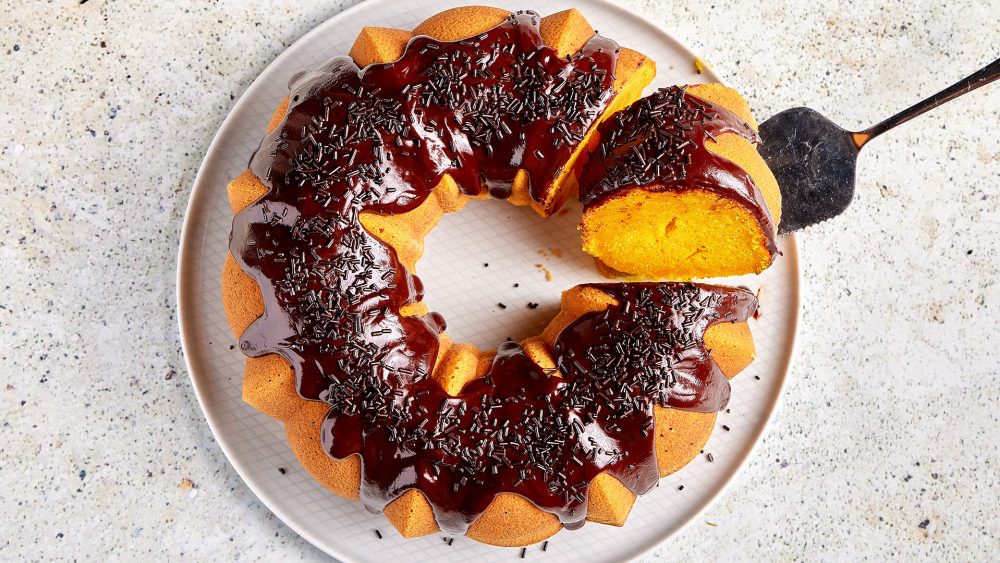Brazilian-style carrot cake is a completely different beast.
It’s just one member of the blender cake family, known as bolos de liquidificador in Brazil. For this cake, the carrots aren’t shredded, but blended right into the batter, giving the cake a vivid orange hue, sweet, earthy flavor, and a crumb that’s so moist, it’s virtually impossible to overbake.
Why you should blend instead of grate
When our kitchen team was first developing this recipe, they assumed it was a high volume of carrots that gave the Brazilian cake its color and flavor, but the prep method ended up being the key. Turns out, the more you rupture the cell structure of root vegetables such as carrots, the more sugars and flavorful hydrocarbons they release. It’s a technique we use often in salads at Milk Street. For salads that taste sweeter and fresher, we grate carrots rather than slice or chop. Pureeing takes this effect to another level.
As a test, we experimented with making bolo de cenoura using grated carrots. It turned out far drier, lacking not only the dramatic color of the blender version, but also its richness. The results were clear: The blender makes all the difference. That’s great news, because blending is much easier and faster than grating.
Blend, pour, mix, bake
Blending the carrots with eggs, sugar, coconut cream and oil until smooth before introducing them to the dry ingredients emulsifies the fat and water by force, rendering the mixture completely homogenous and smooth. Very little stirring is needed to incorporate the wet portion of the batter into the dry, eliminating the risk of gluten formation and promoting a tender (not chewy) crumb. Using oil has an extra advantage: It stays liquid as it cools. By contrast, cakes made with butter tend to firm up as they cool, as the butter re-solidifies even at room temperature.
Once the blended mixture has been (gently) mixed into the flour, baking powder, and salt, all you have to do is pour it into a prepared Bundt pan and pop it in the oven.
Your toothpick should be pristine
The extra moisture from the carrots makes this cake almost impossible to overbake. In fact, it’s far more likely you’ll underbake it. Trust your senses over the clock. Depending on your oven, the cake may need a few extra minutes to bake through. To ensure your cake comes out moist but not stodgy, check several spots with a toothpick, about two inches in from the edges—each toothpick should emerge completely clean, with no crumbs clinging to the wood, not even tiny ones.
Skip the cream cheese in favor of a chocolate glaze
While American carrot cake is heavily frosted with a mixture of cream cheese and cloying powdered sugar, we chose a simple semisweet chocolate glaze for this carrot cake. Glazes are a classic choice for Bundt cakes, as they enrobe the cake, complementing its shape. They’re also much more forgiving if you’re new to decorating cakes—you won’t even need an offset spatula.
And though chocolate glazes can run a wide gamut (for example, some call for gelatin), our version requires nothing more than semisweet chocolate, orange juice and oil.
Bring orange juice to a simmer, then whisk it into the chocolate until smooth and add oil for luster. The juice brightens the glaze while complementing the chocolate, for a cake that tastes as vibrant as it looks. Once the glaze has cooled to room temperature, all you have to do is spoon it over the cake and let it cascade down the sides. (Make sure your cake has cooled completely, otherwise the glaze will slide right off.) Garnish with your sprinkles of choice; chocolate sprinkles give cake a monochrome kind of chicness, but a smattering of pastel sprinkles would make it look right at home on an Easter dessert table.
More of a visual learner? Watch resident baker Rose Hattabaugh make in on Instagram.
Join the conversation on Facebook, Instagram, TikTok and Pinterest.
And if you're looking for more Milk Street, check out our livestream cooking classes with our favorite chefs, home cooks and friends for global recipes, cooking methods and more.








